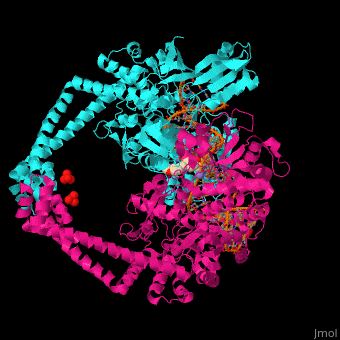Gyrase
From Proteopedia
|
Gyrase (Gyr) is a type of topoisomerase II in prokaryotes which unwinds double stranded DNA. The DNA Gyr cutting allows the formation of a negative DNA supercoil which enables replication of DNA. Gyr consists of 2 subunits: GyrA and GyrB. Reverse gyrase (Top-RG) is a type of topoisomerase I which catalyses the formation of positive DNA supercoil. [1]
Contents |
3D Structure of Gyrase
Gyrase Subunit A
3l6v – GyrA C-terminal – Xanthomonas campestris
2wl2 – EcGyrA N-terminal+simocylinone – Escherichia coli
1ajb - EcGyrA N-terminal+novobiocin
1zi0, 1ab4 - EcGyrA C-terminal
1x75 – EcGyrA14+CcdB
3ilw - MtGyrA N-terminal – Mycobacterium tuberculosis
1suu - GyrA C-terminal – Borrelia burgdorferi
Gyrase Subunit B
3g75, 3g7b, 3g7e – GyrB+thiazole inhibitor – Staphylococcus aureus
2cjt - MtGyrB C-terminal
3cwv – GyrB truncated – Myxococcus xanthus
1kzn, 1ei1 - EcGyrB N-terminal+clorobiocin
1kij – GyrB domain+novobiocin – Thermus thermophilus
Reverse Gyrase
1gku – AfTop-RG – Archaeoglobus fulgidus
1gl9 - AfTop-RG+ADPNP
Additional Resources
For additional information, see: Bacterial Infections
References
- ↑ Gore J, Bryant Z, Stone MD, Nollmann M, Cozzarelli NR, Bustamante C. Mechanochemical analysis of DNA gyrase using rotor bead tracking. Nature. 2006 Jan 5;439(7072):100-4. PMID:16397501 doi:10.1038/nature04319
Proteopedia Page Contributors and Editors (what is this?)
Michal Harel, Alexander Berchansky, David Canner, Joel L. Sussman

